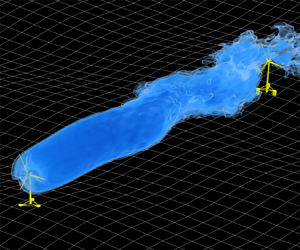Crossref Citations
This article has been cited by the following publications. This list is generated based on data provided by
Crossref.
Lin, Jianfeng
Wang, Shizhao
Yao, Hua-Dong
and
Su, Yumin
2024.
Intelligent control of the Magnus anti-rolling device: A co-simulation approach.
Ocean Engineering,
Vol. 312,
Issue. ,
p.
119304.
Li, Yunliang
Zhang, Fengshun
Li, Zhaobin
and
Yang, Xiaolei
2024.
Impacts of inflow turbulence on the flow past a permeable disk.
Journal of Fluid Mechanics,
Vol. 999,
Issue. ,
Li, Zhaobin
Li, Yunliang
and
Yang, Xiaolei
2024.
Large eddy simulation and linear stability analysis of active sway control for wind turbine array wake.
Physics of Fluids,
Vol. 36,
Issue. 7,
Messmer, Thomas
Peinke, Joachim
and
Hölling, Michael
2024.
Wind tunnel investigation on the recovery and dynamics of the wake of a floating offshore wind turbine subjected to low inflow turbulence.
Journal of Physics: Conference Series,
Vol. 2767,
Issue. 9,
p.
092083.
Wei, Nathaniel J.
El Makdah, Adnan
Hu, JiaCheng
Kaiser, Frieder
Rival, David E.
and
Dabiri, John O.
2024.
Wake dynamics of wind turbines in unsteady streamwise flow conditions.
Journal of Fluid Mechanics,
Vol. 1000,
Issue. ,
Dong, Xiaochen
Qu, Hengliang
Li, Pengfei
and
Zhu, He
2025.
Three-dimensional numerical study on the energy-harvesting performance of tandem hydrofoils with different fore and hind hydrofoil parameters.
Physics of Fluids,
Vol. 37,
Issue. 4,
Wu, Chutian
Zhang, Xin-Lei
and
He, Guowei
2025.
Neural operator-based stochastic forcing for resolvent prediction of space–time turbulence statistics in channel flows.
Journal of Fluid Mechanics,
Vol. 1024,
Issue. ,
Li, Wenfeng
Zhao, Zhenzhou
Dong, Guodan
Liu, Yige
Liu, Huiwen
Wei, Shangshang
Ali, Kashif
Liu, Yan
and
Ma, Yuanzhuo
2025.
Effects of heave frequency and amplitude on wake evolution of floating offshore wind turbine in smooth flow conditions.
Ocean Engineering,
Vol. 340,
Issue. ,
p.
122401.
Martinez-Trespalacios, José
Barile, Dimas
Millan-Gandara, John
Useche, Jairo
and
Otero, Alejandro
2025.
Combined Effect of ABL Profile and Rotation in Wind Turbine Wakes: New Three-Dimensional Wake Model.
Energies,
Vol. 18,
Issue. 17,
p.
4726.
Wenfeng, Li
Zhenzhou, Zhao
Yige, Liu
Huiwen, Liu
Shangshang, Wei
Ali, Kashif
Guodan, Dong
Yan, Liu
and
Yuanzhuo, Ma
2025.
Investigation of dynamic wake model of a floating offshore wind turbine under heave, surge and pitch motion.
Renewable Energy,
Vol. 254,
Issue. ,
p.
123665.
Li, Zhaobin
and
Yang, Xiaolei
2025.
Self-consistent model for active control of wind turbine wakes.
Journal of Fluid Mechanics,
Vol. 1013,
Issue. ,
Messmer, Thomas
Peinke, Joachim
Croce, Alessandro
and
Hölling, Michael
2025.
The role of motion-excited coherent structures in improved wake recovery of a floating wind turbine.
Journal of Fluid Mechanics,
Vol. 1018,
Issue. ,
Wu, Xiaodi
Li, Jiaqi
Lu, Wenhao
and
Chen, Jiahao
2025.
Wake prediction of a fully coupled floating wind turbine using dynamic mode decomposition and bidirectional long short-term memory method.
Physics of Fluids,
Vol. 37,
Issue. 11,
Mian, H.H.
Messmer, T.
Stoevesandt, B.
and
Siddiqui, M.S.
2025.
Coherent flow structures in the wake of a model floating wind turbine under pitch and roll motions.
Energy,
Vol. 335,
Issue. ,
p.
138212.
Liang, Junwen
Tu, Xinuo
Liang, Zebin
Zhao, Mengshang
and
Zha, Ruosi
2025.
Internal flow characteristics of a tank with multiple jet inflows and liquid sloshing.
Physics of Fluids,
Vol. 37,
Issue. 4,
Sun, Shaonan
Li, Mengna
Shi, Yifan
Liu, Chunlu
and
Wang, Ailing
2025.
Integrating BIM Forward Design with CFD Numerical Simulation for Wind Turbine Blade Analysis.
Energies,
Vol. 18,
Issue. 15,
p.
3989.
Cheung, Lawrence
Yalla, Gopal
Mohan, Prakash
Hsieh, Alan
Brown, Kenneth
deVelder, Nathaniel
Houck, Daniel
Henry de Frahan, Marc T.
Day, Marc
and
Sprague, Michael
2025.
Modeling the effects of active wake mixing on wake behavior through large-scale coherent structures.
Wind Energy Science,
Vol. 10,
Issue. 7,
p.
1403.
Zhang, Huiying
Ning, Dezhi
Wu, Ting
and
He, Guowei
2025.
Evaluation of the random sweeping hypothesis for the Reynolds normal stress fluctuation spectra.
Physics of Fluids,
Vol. 37,
Issue. 4,
Hubert, Antonin
Conan, Boris
and
Aubrun, Sandrine
2025.
Spatiotemporal behavior of the far wake of a wind turbine model subjected to harmonic motions: phase averaging applied to stereo particle image velocimetry measurements.
Wind Energy Science,
Vol. 10,
Issue. 7,
p.
1351.
Yang, Xiaolei
Sotiropoulos, Fotis
and
Sørensen, Jens Nørkær
2026.
Wind farm fluid mechanics for high-penetration wind energy.
Renewable and Sustainable Energy Reviews,
Vol. 226,
Issue. ,
p.
116260.



